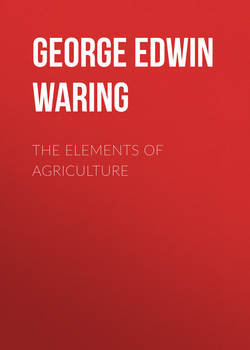Читать книгу The Elements of Agriculture - George Edwin Waring - Страница 7
SECTION FIRST.
THE PLANT
CHAPTER V
ОглавлениеGROWTH
Of what does a perfect young plant consist?
How must the food of plants be supplied?
Can carbon and earthy matter be taken up at separate stages of growth, or must they both be supplied at once?
Having examined the materials of which plants are made, it becomes necessary to discover how they are put together in the process of growth. Let us therefore suppose a young wheat-plant for instance to be in condition to commence independent growth.
It consists of roots which are located in the soil; leaves which are spread in the air, and a stem which connects the roots and leaves. This stem contains sap vessels (or tubes) which extend from the ends of the roots to the surfaces of the leaves, thus affording a passage for the sap, and consequently allowing the matters taken up to be distributed throughout the plant.
What seems to be nature's law with regard to this?
What is the similarity between making a cart and raising a crop?
In the growth of a young plant, what operations take place about the same time?
It is necessary that the materials of which plants are made should be supplied in certain proportions, and at the same time. For instance, carbon could not be taken up in large quantities by the leaves, unless the roots, at the same time, were receiving from the soil those mineral matters which are necessary to growth. On the other hand, no considerable amount of earthy matter could be appropriated by the roots unless the leaves were obtaining carbon from the air. This same rule holds true with regard to all of the constituents required; Nature seeming to have made it a law that if one of the important ingredients of the plant is absent, the others, though they may be present in sufficient quantities, cannot be used. Thus, if the soil is deficient in potash, and still has sufficient quantities of all of the other ingredients, the plant cannot take up these ingredients, because potash is necessary to its life.
If a farmer wishes to make a cart he prepares his wood and iron, gets them all in the proper condition, and then can very readily put them together. But if he has all of the wood necessary and no iron, he cannot make his cart, because bolts, nails and screws are required, and their place cannot be supplied by boards. This serves to illustrate the fact that in raising plants we must give them every thing that they require, or they will not grow at all.
In the case of our young plant the following operations are going on at about the same time.
The leaves are absorbing carbonic acid from the atmosphere, and the roots are drinking in water from the soil.
What becomes of the carbonic acid?
How is the sap disposed of?
What does it contain?
How does the plant obtain its carbon?
Its oxygen and hydrogen?
Its nitrogen?
Its inorganic matter?
Under the influence of daylight, the carbonic acid is decomposed; its oxygen returned to the atmosphere, and its carbon retained in the plant.
The water taken in by the roots circulates through the sap vessels of the plant, and, from various causes, is drawn up towards the leaves where it is evaporated. This water contains the nitrogen and the inorganic matter required by the plant and some carbonic acid, while the water itself consists of hydrogen and oxygen.
Thus we see that the plant obtains its food in the following manner:—
What changes does the food taken up by the plant undergo?
Many of the chemical changes which take place in the interior of the plant are well understood, but they require too much knowledge of chemistry to be easily comprehended by the young learner, and it is not absolutely essential that they should be understood by the scholar who is merely learning the elements of the science.
It is sufficient to say that the food taken up by the plant undergoes such changes as are required for its growth; as in animals, where the food taken into the stomach, is digested, and formed into bone, muscle, fat, hair, etc., so in the plant the nutritive portions of the sap are resolved into wood, bark, grain, or some other necessary part.
The results of these changes are of the greatest importance in agriculture, and no person can call himself a practical farmer who does not thoroughly understand them.
